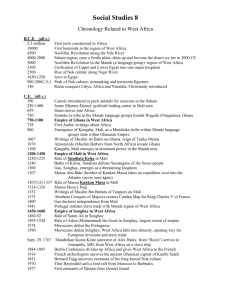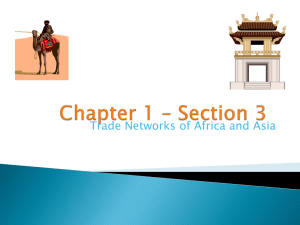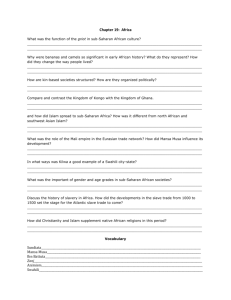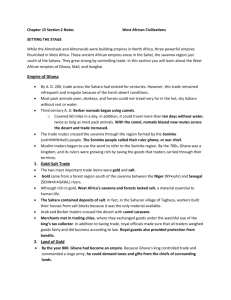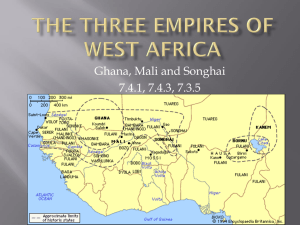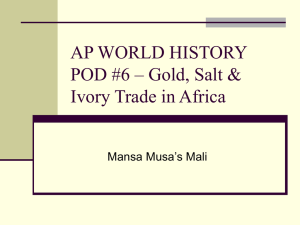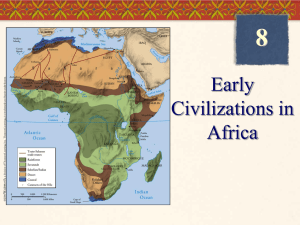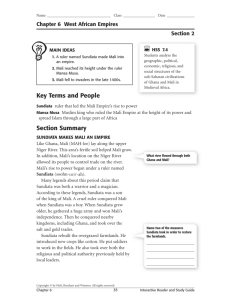Mansa Musa
advertisement
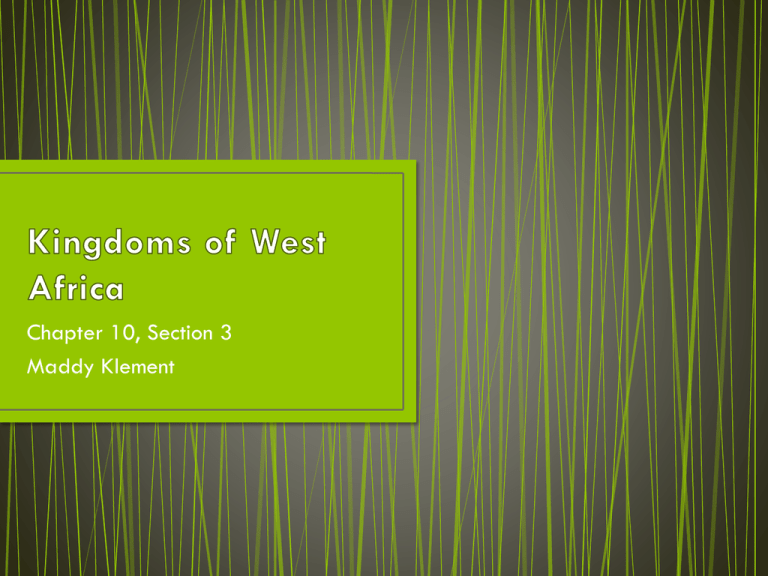
Chapter 10, Section 3 Maddy Klement • The expansion of trade across the Sahara led to the development of great empires and other states in West Africa. • Sundiata: (died 1255) Founder and ruler of Mali; he organized an army and defeated the other kingdoms of West Africa. • Mansa Musa: (died 1332) Leader of Mali who held power from 1307 to 1332; he conquered the Kingdom of Songhai. He expanded trade, supported the arts, and promoted Islam. • By the 800’s, the kingdom of Ghana had a powerful empire- made possible by all the gold they traded. • They didn’t always have trade, though. The Sahara isolated Ghana from the rest of Africa. • In the first few centuries AD, the north African traders learned how to cross the desert. • They traded food, manufactured goods, and copper for their gold. The Berber traders also traded salt, which Ghana in turn traded to people in the south, where salt was scarce. • Ghana’s capitol, Koumbi-Saleh, was a popular trading area. • By A.D. 800, Ghana controlled all trade of gold and salt • When Ghana’s king tried to expand the kingdom to the north, a conflict arose between Ghana and the Almoravids. • Finally in 1076, the Almoravids captured Koumbi-Saleh. This left the empire weakened. Then people in part of the empire rebelled, and the empire crumbled. -How did trade contribute to the rise of Ghana? Ghana became a strong empire through their trade of gold. -When were camels first used to cross the desert? In the first few centuries A.D. -Why would salt have been particularly valuable to sub-Saharan people? They didn’t have any, and it is necessary in their diets. -How did the kings control the value of gold? They kept all the gold nuggets to themselves, and only let the people have gold dust. They also taxed it, and regulated the flow of it to make sure it stayed valuable. - How did the temporary control of Koumbi-Saleh by the Almoravids cause the decline of the kingdom of Ghana? It weakened the empire, and then a group of people rebelled. • The empire Mali rose to power in the 1230’s. Mali expanded to the Atlantic ocean, and became a rich and sophisticated empire. • The Malinke people, the founders of Mali, became frustrated with the policies of neighboring lands, and conquered them around 1230. • Mali then became the leading power in West Africa. • The person who led this was Sundiata, and after he had conquered the neighboring lands, he ruled for 25 years. • Mali reached its height under Mansa Musa in the 1300’s. • Under Mansa Musa, the territory, population, and wealth grew. • Most of this wealth came from taxing the gold-salt trade. They kept this trade under control by using a large army. • Mansa Musa, like many other Mali rulers after Sundiata, was a Muslim. • In 324, Mansa Musa set out on a pilgrimage to Mecca. He took a caravan of more than 60,000 people. They gave away a lot of gold to the different people they would meet. • He brought back artists and architects who built beautiful mosques and schools. • Timbuktu became West Africa’s center for education, religion, and culture. • Mansa Musa’s pilgrimage brought attention to Mali, not only from other parts of Africa, but also from Europe. • A series of weaker kings after Mansa Musa weakened Mali, and by the 1300’s, it was in shambles. • While Mali was weak, people from outside of Mali invaded it, and in 1433, the Tuareg invaded and captured Timbuktu, and Mali slowly declined from there. -How did strong rulers build the empire of Mali? They conquered neighboring lands and took control of the gold and salt trade. -When did the Mali empire rise to power? In the 1230’s -What one act made Mansa Musa especially famous? Mansa Musa’s pilgrimage made him and Mali famous. -Name three things for which Timbuktu became renowned. Education, religion, and culture -How might Mansa Musa’s show of wealth have created a problem for his country’s future? It made people interested in conquering this wealthy land. • Who was it that took a pilgrimage to Mecca? A) Mansa Musa B) Sundiata C) Socrates D) None of the above • http://www.bing.com/images/search?q=gold&qs • http://www.africaimagelibrary.com/media/61d66894-214511e0-8b64-41a743b4a5e4-tuareg-travelling-by-camel-in-thesahara-desert-outside-timbuk • http://www.bing.com/images/search?q=timbuktu&qs=n&form =QBIR&pq=timbuktu&sc=8-8&sp=1&sk=#view=detail&id=773F91A1B120CD73CA6585B8ECD BFFF1E70071FC&selectedIndex=167 • Hold World History textbook

